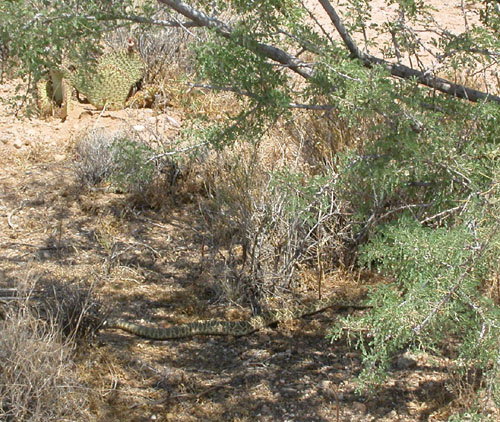Features > Camping > Snake Population Explosion
Two weeks ago we were hiking the path in Bandelier National Monument and heard the telltale rattle. Less than eight inches away, a four-foot-long Western Diamondback Rattlesnake slithered past my first-grader. If that snake chose to strike, my child probably wouldn't be here today.

Mojave Green Rattlesnake. A catch-in-garage-and-release in Arizona.
New Mexico's snake population is booming this year. Heavy rainfall and abundant rodent populations mean snakes are fat, happy and multiplying. A recent report by a local new station suggested three times as many rattlers had been caught and transported away from the Los Alamos area this summer. Rattlers have been spotted around Santa Fe as well.
With proper precautions, there's no reason why you can't still enjoy a hike. The key is to be extra vigilant. Here are some additional tips to snake safety:
- Walk well-maintained trails. Snakes (and rodents) tend to congregate around debris and in tall grass.
- Wear high-top shoes and long pants.
- Be noisy. Let your feet thud into the ground.
- Keep children in the middle of the group.
- Always look before stepping over logs, rocks and debris.
- Continually scan the area around the trail.
- Walk around snakes. Or stop and let them slither away. For the most part, snakes are afraid of you.
- Snakes are usually most active in the mornings and evenings. Be more cautious when out at dawn or dusk.
- Bites are most common in spring and fall.
- Travel with a snakebite kit like Venex Snake Bite Pocket Kit ($10).
If you or someone in your party is bitten by a snake:
- Stop moving immediately.
- Keep the bitten area below heart level.
- Remove jewelry and any other constricting object from that arm or leg.
- Get to a hospital as soon as possible.
- Do not ever try to suck out the venom.
- Do not apply ice to the bite.
- Do not apply a tourniquet or other constricting device.
By Anna Philpot